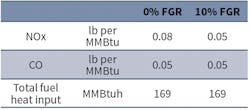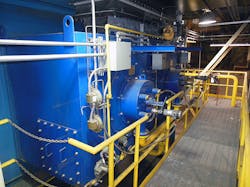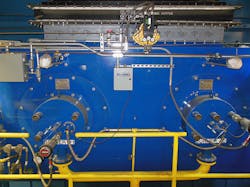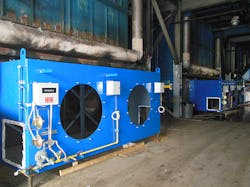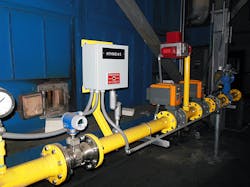Wright-Patterson Air Force Base Coal-to-Natural-Gas Boiler Conversion
In 2012, Wright-Patterson Air Force Base (WPAFB) near Dayton, Ohio, faced the daunting task of bringing two of its central heating plants into compliance with the new Maximum Achievable Control Technology (MACT) emission limits for boilers established by the U.S. Environmental Protection Agency.
Historically, the base had operated separate centralized steam and high-temperature-hot-water (HTHW) systems, utilizing natural-gas- and coal-fired boilers to provide steam and hot water to more than 14.5 million sq ft of occupied space. Analysis showed that, with the existing air-pollution-control systems, the coal-fired boilers would not meet the new Boiler MACT standards for mercury, hydrochloric acid, and particulate.
With a compliance date looming, the base initiated a project intended to modify the existing coal-fired boilers to meet National Emission Standards for Hazardous Air Pollutants for Major Sources: Industrial, Commercial, and Institutional Boilers and Process Heaters. The result was a successful conversion to cleaner-burning natural gas that resulted in a reduction in greenhouse-gas emissions of nearly 50 percent.
Existing Conditions
The steam plant provided heat to more than 8 million sq ft with two 80,000-PPH natural-gas-fired package boilers and three coal-fired boilers. The coal-fired boilers were stoker-fired balanced-draft, saturated-steam units manufactured in 1979. Designed with a maximum continuous steam capacity of 150,000 PPH, the units now were limited by emissions permit to a steam rate of 136,000 PPH and a heat input of 169 MMBtuh.
The HTHW plant provided heat to nearly 6.5 million sq ft with one 80-MMBtu-output natural-gas-fired high-temperature-hot-water generator (HTHWG) and three coal-fired HTHWGs. The coal-fired HTHWGs were stoker-fired balanced-draft units manufactured in 1978, originally designed with a maximum heat output of 130 MMBtuh.
Design Process
Because of successful energy-conservation measures and the recent decentralization of WPAFB’s heating systems, project managers decided to convert just two coal-fired boilers and two coal-fired HTHWGs. The remaining units were slated for demolition. The newly converted boilers and HTHWGs would utilize new natural-gas-fired low-nitrogen-oxide (NOx) burners with a maximum allowable emission rate of 0.1 lb per million British thermal units for NOx and 0.1 lb per million British thermal units for carbon monoxide (CO).
The first task of the design process was to determine whether the boilers and HTHWGs were suited for a fuel conversion. A computational-fluid-dynamics-based software program was used to model boiler performance from a theoretical standpoint and then “tuned” to replicate actual operating data and account for fouling, flow distributions, and other anomalies that might affect heat transfer within the boilers. Models were created under different operating scenarios with and without flue-gas recirculation (FGR). The results are shown in tables 1 and 2.
Given the models for both the steam plant and the HTHW plant predicted stack-emission levels within the MACT requirements, project managers concluded with reasonable certainty the coal-fired boilers in both plants were good candidates for fuel conversion.
Two configurations were considered for the new natural-gas burners: a single upfired burner or two wall-mounted burners.
Upfiring a single burner often makes sense when converting from coal to natural gas; differences in performance are minimal. In both plants, following removal of the coal grate and ash-collection equipment, there was ample space below the boilers for an upfired burner; however:
- The furnaces in the HTHWGs were deemed too short to accommodate an upfired burner without impingement on the ceiling of the units.
- Installation of an upfired burner at the steam plant would have required more extensive modification of the combustion-air ductwork, which would have increased installation costs.
At the HTHW plant, project managers determined installing two burners on the front wall of the HTHWGs—where coal feeders formerly were located—would result in shorter flames that would not contact the rear wall. Additionally, no tube modifications would be required. At the steam plant, project managers concluded that, with the rear wall of the boilers in desperate need of retubing, openings for new burners easily could be provided as part of retubing work (Photo A).
Thus, it was determined that natural gas would be fired in two natural-gas burners mounted on the front wall of each HTHWG at the HTHW plant and on the rear wall of each boiler at the steam plant. The burners would be unison-fired, meaning fuel and air would be controlled together by the same fuel and air systems and the burners would not be able to fire individually (Photo B).
Modern gas burners capable of 10:1 turndown (100 percent to 10 percent capacity) provide sufficient operating range to accommodate load carrying and standby modes. Firing such burners in unison simplifies burner-management systems (BMS), fuel-safety piping, and associated controls, keeping overall project costs in check.
Required Furnace Modifications
With the HTHWGs, new windbox/burner assemblies were installed in the front wall, where coal distributors were located previously (Photo C). The front walls needed to be rebuilt to accommodate the new burners. To avoid tube and header modifications, the windbox was lowered to a point at which the traveling grate was in the way and had to be removed. Without a stoker in place, structural steel was needed to build a new furnace floor. The floor was covered with lightweight insulating refractory fire brick.
With the steam boilers, new windbox/burner assemblies were installed in the rear wall, high enough above the traveling grate that it could stay in place and form the floor of the furnace. The stoker and other non-cooled components required protection from radiant heat so structural integrity could be maintained. Additionally, air leakage into the boiler needed to be minimized for the units to operate with the required NOx emission rates. Four coal distributors were removed from the front wall, with two of the resultant openings sealed with steel plates on the outside and refractory on the inside and the other two converted into access doors with removable refractory plugs. All overfire air and ash reinjection ports were filled with refractory from the inside. The traveling grate stoker and all chains, clips, and other accessories were abandoned in place and covered with lightweight insulating refractory fire brick. All voids along the edges of the stoker were filled with loose mineral-wool insulation to minimize air leakage. The original grate temperature transmitters were kept in place so grate temperature could be monitored during operation to ensure the abandoned stoker would not overheat.
Results
The first plant to be converted was the steam plant. New windbox and burner assemblies, forced-draft fans, induced-draft fans, combustion controls, and BMS were retrofitted to each unit and performance-tested. To everyone’s satisfaction, 1979 vintage boilers nos. 3 and 4 reached their original nameplate output capacity, temperature, and pressure.
Average peak steam loads were measured at 126,500 PPH during startup testing. This was just under the permit rating of 130,000 PPH. Average NOx levels were measured at 0.0874 lb per million British thermal units, and CO levels were measured at 0.0014 lb per million British thermal units. Testing showed both boilers’ emissions were less than the specified maximum allowable levels of 0.1 lb per million British thermal units for NOx and 0.1 lb per million British thermal units for CO.
While the upgrades were focused on reducing emission of specific pollutants, an equally notable result was the fact greenhouse-gas carbon-dioxide (CO2) emissions were reduced by 50 percent as a result of converting from coal to natural gas. Tens of thousands of tons of CO2-emission reductions per year will help WPAFB reach its sustainability goal.
The boiler modifications at the steam plant were completed in 2016, and the new burners are now fully operational. Modifications at the HTHW plant are under way and expected to yield similar results.
Dave Mercer, PE, is a mechanical engineer with experience in the analysis and design of steam and chilled-water generation and distribution systems in campus environments. His expertise includes the design of automated mechanical systems, utility metering, energy optimization, and the evaluation of existing-building domestic-water systems. He can be reached at [email protected].
Did you find this article useful? Send comments and suggestions to Executive Editor Scott Arnold at [email protected].


